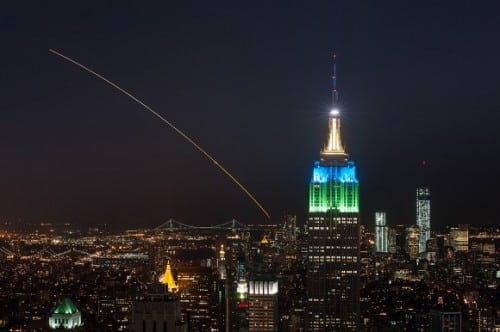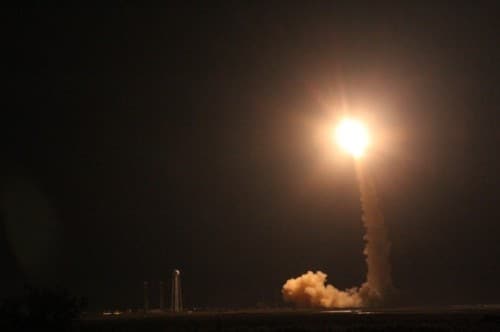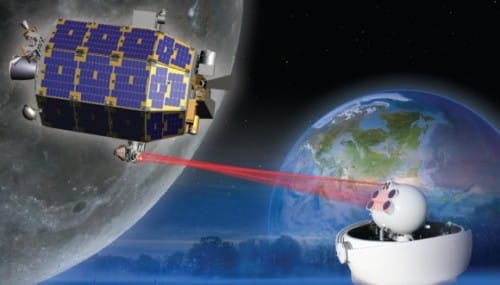A messenger of the universe today website reports from the launch center on Wallops Island * "It was a perfect launch" said NASA Deputy Administrator John Grunsfeld in a press briefing after the launch on Wallops Island. "LADEE will help us uncover the mysteries of the moon's atmosphere."

By Ken Cramer
A new NASA lunar rover was launched tonight (September 6 in the US, the morning of September 7 Israel time) while leaving behind a spectacular trail. The launch site was unusual - yes a launch on the coast of Wallops Island in Virginia, and was watched by millions of people visiting the east coast of the USA thanks to clear skies and the night launch time.
Legions of tourists came to the beaches of Virginia to watch the launch into space, which until now had been reserved mainly for residents of Florida and California.
Everyone I spoke to was mesmerized by the spectacular beauty of the Minotaur 5 launch, and cheered as the crackling fire cracked the night sky with a tremendous noise.
"It was a perfect launch," said NASA Deputy Administrator John Grunsfeld at a press briefing after the launch on Wallops Island. "Lady will help us uncover the mysteries of the moon's atmosphere." The spacecraft, dust exploring Lunar Atmosphere and Dust Environment Explorer (LADEE) is the first spacecraft launched after NASA's launch on Wallops Island. The Minotaur 5 rocket that shows up exactly on time - 23:27 EST on the maiden flight of the rocket and then launch 0B.
This is what the launch looks like from the window of a house in Washington
"The spacecraft is in good condition and separated from the fifth and final stage on time, about 23 minutes after launch," says Pete Worden to the Universe Today website. Worden is the director of NASA's Ames Space Research Center whose people designed and built Lady using completely new design methods that enabled cost reduction and increased scientific output.

The new launch is the first of a five-stage missile and the first launch of a Peacekeeper intercontinental ballistic missile that has been truly converted for peacetime. The Peacekeeper was a nuclear intercontinental ballistic missile built during the Cold War and now being refurbished by Orbital Sciences.
The fifth stage of the Minotaur 5 rocket launched Lady into an extremely elliptical orbit. Over the next 23 days, as Ladi orbits the Earth 3.5 times, the Moon's gravitational field will increase the gyration of its orbit. The spacecraft will fire its internal engines to take advantage of this and reach lunar orbit.
When the spacecraft reaches the moon, it will become its satellite and orbit it at a very low altitude of about 50 kilometers above the surface, which will require a large amount of fuel. The scientific mission will last about 100 days. The capsule, which weighs 383 kg and is about the size of an armchair, was assembled at NASA's Ames Space Research Center in Mott Field, California and in collaboration with NASA's Goddard Space Flight Center in Maryland. It is equipped with three scientific instruments aimed at collecting data that will increase scientific knowledge of previously unknown details about the Moon's very thin atmosphere, its environmental impact on lunar dust, and near-surface conditions in general. The purpose of the mission, which costs 280 million dollars, is to obtain a deep understanding of all the details that are still unknown today about the thin atmosphere, dust and their mutual influence on the surface and which will help to understand what is happening on other celestial bodies.

The small spacecraft is built on a modular body of spacecraft, a new development that may dramatically reduce the cost of space exploration as well as be used by many spacecraft that will fly to many bodies in the solar system. The cost of construction and launch, as mentioned, amounted to a relatively low amount - 280 million dollars. "LADEE is the first of a new type of interplanetary research mission," Worden tells Universe Today. "She will explore the primordial moon to answer important questions. This is perhaps the last opportunity to explore the virgin moon before a lot of human activity on it changes its nature."
The height of the new Mintaur 5 missile is 24.6 m, its diameter is 2.3 meters and it weighs 89,373 kg. The first three stages of the missile are based on the intercontinental nuclear armed Peacekeeper ICBM, which was built during the Cold War and has now been converted by Orbital Sciences for peace purposes. The fifth stage is a new addition that makes Mintaur the first of a new type of launcher. The additional thrust is what makes Mentaure 5 an accelerator for spacecraft beyond Earth's orbit, which enabled the launch to the moon.
More on:
